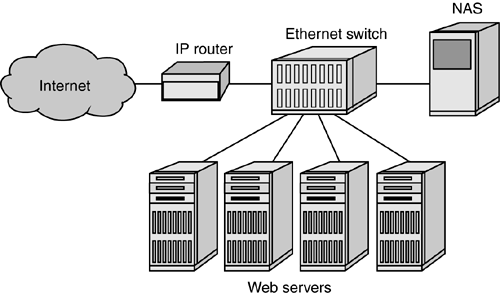12.6 Internet Service Providers
| Internet service providers that provide Web hosting services have traditionally implemented servers with internal or SCSI-attached storage. For smaller ISPs, internal or direct-attached disks are sufficient as long as storage requirements do not exceed the capacity of those devices. For larger ISPs hosting multiple sites, storage requirements may exceed the SCSI-attached capacity of individual servers. Network-Attached Storage (NAS) or SANs are viable options for supplying additional data storage for these configurations. In addition to meeting storage needs, maintaining availability of Web services is critical for ISP operations. Because access to a Web site (URL) is based on Domain Name System (DNS) addressing rather than physical addressing, you can deploy redundant Web servers as a failover strategy. If a primary server fails, another server can assume access responsibility via round-robin DNS address resolution. For sites that rely on internal or SCSI-attached storage, this technique implies that each server and its attached storage must maintain a duplicate copy of data. This solution is workable so long as the data itself is not dynamic that is, it consists primarily of read-only information. This option is less attractive, however, for e-commerce applications, which must constantly update user data, on-line orders, and inventory tracking information. The shift from read-mostly to more dynamic read/write requirements encourages the separation of storage from individual servers. With NAS or SAN-attached disk arrays, data is more easily mirrored for redundancy and is made available to multiple servers for failover operation. As Figure 12-9 illustrates, NAS provides common data access over shared or switched Ethernet, allowing multiple Web servers to exist in a failover configuration. Figure 12-9. A small ISP implementation using network-attached storage
SAN architecture brings additional benefits to ISP configurations by providing high-speed data access between servers and storage using block I/O instead of NFS or CIFS file protocols and by enabling scalability to much higher populations of servers. As shown in Figure 12-10, you can extend the SAN with additional switch ports to accommodate expansion of storage capacity and increased population of Web servers. This small configuration can scale to hundreds of servers and terabytes of data with no degradation of service. Backup operations can also be streamlined using server-free backup, as discussed earlier. Figure 12-10. ISP configuration built with (a) iSCSI or (b) Fibre Channel
The upper diagram (a) in Figure 12-10 depicts a scalable ISP configuration using iSCSI for block I/O access to storage and tape. In this case, the Ethernet switch is a common interconnection both for Web traffic via the IP router and for block access to storage data. Although servers can be provisioned with dual Ethernet links to segregate file and block traffic using VLANs, some iSCSI adapters support file and block I/O on the same interface. Depending on bandwidth requirements, this solution may minimize components and wiring and simplify the configuration. The lower diagram (Figure 12-10b) shows the functional equivalent to (a) but uses Fibre Channel instead of iSCSI. This configuration introduces additional devices and connections but fulfills the requirement for high performance and scalable access to shared storage resources. |
EAN: 2147483647
Pages: 171

